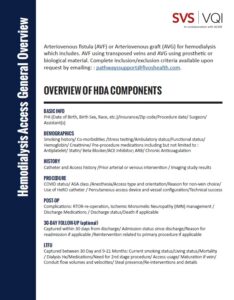IN THIS SECTION
FEATURED NEWS
FEATURED EVENTS
Hemodialysis access
The Vascular Quality Initiative (VQI) Hemodialysis Access Registry captures all Arterio- venous fistulas and grafts procedures. This includes A-V fistulas using transposed veins and A-V grafts using autogenous, prosthetic or biological material.
The Hemodialysis Access Registry DA registry integrates with the FDA Global Unique Device Identification Database (GUDID) for easier capture of prosthetic graft manufacturer and device details. This allows users to search for a device using the GUDID Device Identifier (DI) or the device Product Number, and auto-populate all the device details (Manufacturer, Brand Name/Device Type, Length, Diameter, etc.). If the DI or Product Number of the device is unknown, the users can also select the device details and the registry will auto-populate the DI and Product Number if there is a match in GUDID.
Inclusion criteria for HDA
Autogenous arteriovenous (AV) fistulas and prosthetic grafts. This includes AV fistulas (AVF) using transposed veins and AV graft (AVG) using prosthetic or biological material. Also, include AV access performed using open or endovascular techniques. Note: The second stage of Hemodialysis Access procedure (i.e., basilic transposition) should be captured on the follow-up form for the original procedure.
exclusion criteria for HDA
- All dialysis catheters (tunneled or not tunneled)
- Thrombectomy or revision of existing access (which is captured on follow-up form from initial access procedure)
- Percutaneous thrombectomy, angioplasty or stenting of existing access (which is captured on follow-up form from initial access procedure)
- DRIL or other procedure performed for ischemia related to existing access (which is captured on follow-up form from initial access procedure)

REGISTRY OVERVIEW

